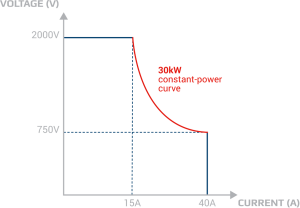What is Autoranging?
“Autoranging” is the term used to describe the ability of a programmable DC source to maintain full power output across a wider range of output voltages and currents than traditional DC power supplies. As shown by the box labelled “Limited power stage (standard)” in the figure below, traditional DC power supplies only offer maximum power output at full scale output voltage because output current is limited to a specified value. In most applications, however, a device under test will not require a power supply’s full-scale voltage, meaning that the power supply is being under-utilized. As a result, in many cases, an engineer will have to specify a more expensive power supply that can supply the necessary output power at the required voltage.

Autoranging supplies, on the other hand, are not so constrained. They automatically supply higher output current at lower voltages, and when current outputs are modest, can supply a higher output voltage than traditional supplies. This feature gives autoranging power supplies extra range and more flexible performance than traditional supplies.
Autoranging save money when testing servers
As one example of how it’s used, many server farms are now using 380 VDC power distribution to more efficiently deliver power within data centers. Top manufacturers, such as Cisco and Juniper, have adopted this technology because it saves a significant amount of energy.
The Cisco Nexus 9500 Series Switches, for example, can require up to 3,150 W of power at an input voltage between 192 VDC and 400 VDC. At 192 VDC, the current required will be 3,150 W / 192 VDC, or 16.4 ADC. At 400 VDC, the current required is 3,150 W / 400 VDC, or 7.9 ADC.
So, to properly test these switches, test engineers have to supply a maximum voltage of 400 VDC and a maximum current of at least 16.4 ADC. For the design verification test, the test supply actually has to supply more current, as the test voltage for this test is 180 VDC, meaning that the power supply has to supply 17.5 ADC.
To use a traditional DC power supply for this test, a test engineer would probably choose a supply with a 500 VDC maximum output, and because the supply would have to supply up to 16.4 ADC, the supply would have to supply at least 8,200 W:
And, because most manufacturers offer supplies without output power that are multiples of 5 kW, the test engineer would be forced to select a 10 kW supply to test a product consuming 3,150 W.
Autoranging Advantage
On the other hand, by using an autoranging supply, such as the Elektro-Automatik PSI 9500-30 3U, a test engineer can use a more appropriately-sized supply, thereby saving thousands of dollars. The EA PSI 9500-30 3U is rated at 5,000 W, with an output voltage from 0 – 500 VDC and output current up to 30 ADC. With a power rating of 5,000 W, the EA PSI 9500-30 3U is capable of providing 26 ADC at 192 VDC and 12.5 ADC at 400 VDC.
Even though the EA PSI 9500-30 3U has only half the capacity of the traditional 10 kW supply, it can easily supply the required voltages and currents for this test. And, because, in general, power supplies cost so much per watt, the higher the power, the higher the cost. The cost for an autoranging power supply could be as little as half the cost of the traditional supply.
The bottom line is that autoranging power supplies offer more range and are much more flexible than traditional power supplies. In many applications, test engineers will be able to use a less powerful supply and save on power supply costs.




 Find our Products by Region:
Find our Products by Region: